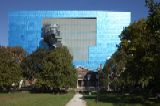|
by
Tony Humphries, McGill
Coauthors: Sue Ann Campbell, Waterloo
Delay
Differential Equations arise in many applications from pharmacokinetics
to ecology to laser physics. While the theory of fixed discrete
delay DDEs is now mature, equations arise from applications with
distributed and/or state-dependent delays which fall outside the
scope of much of this theory. This is a thriving field in Canada,
and recent developments will be presented in this session.
Speakers:
Jacques
Bélair, Université de Montréal
Pharmacokinetics modeling: when the delay is an effect (and
vice-versa)
In
modeling the time course of drug concentration after administration
(pharmacokinetics), the simplest paradigms (instantaneous and
homomogeneous mixing, for example) are oftentimes not entirely
satisfied. This has lead classical phamacokineticians to the introduction
of a so-called Effect compartment, which is, in effect (!!), a
time delay in the kinetic description. We present a proper formulation
of this trickery, including possible consequences of distributions
of delays.
Pietro-Luciano
Buono, UOIT
Bifurcation in symmetric delay-coupled rings of lasers
The
Lang-Kobayashi (LK) equations are a model for semi-conductor lasers.
We study delay-coupled systems of LK equations in a ring with
Z_n and D_n symmetry. The basic solutions are Compound Laser Modes
(CLMs) which are rotating waves and we classify them via their
symmetry. We study steady-state and Hopf bifurcation from CLMs
using DDE-Biftool. However, some results given by DDE-Biftool
on the location of bifurcation points are not accurate and we
use block diagonalization of the linearization using the isotypic
decomposition of the space to find the correct location of bifurcation
points. This is joint work with J. Collera.
Sue Ann Campbell, Waterloo
Centre
Manifolds for Systems with Distributed Delays
Models
for systems with distributed delays often include distributions
that extend to infinite delays. While the theory of centre manifolds
for systems with infinite delay is not complete, formal calculations
can be carried out. We show that these formal calculations can
be verified in certain special cases and consider some approximations
for the centre manifold that can be computed without full knowledge
of the distribution.
Jian
Fang, York
Monotone traveling waves for delayed Lotka-Volterra competition
systems
In
this talk, we consider a delayed reaction diffusion Lotka-Volterra
competition system which does not generate a monotone semiflow
with respect to the standard ordering relation for competitive
systems. We obtain a necessary and sufficient condition for the
existence of traveling wave solutions connecting the extinction
state to the coexistence state, and prove that such solutions
are monotone and unique (up to translation). This talk is based
on a joint work with Dr. Jianhong Wu.
Tony Humphries, McGill
Periodic Solutions of a Singularly Perturbed Differential
Equation with two state-dependent delays
We
consider a singularly perturbed delay differential equation (DDE)
which has two linearly state-dependent delays, and show how to
construct large amplitude periodic solutions in the singular limit
using geometric arguments. Small amplitude solutions, near to
the Hopf bifurcations, are constructed using Lindstedt series.
Hence the bifurcation diagram is constructed in the singular limit.
The bifurcation structures are shown to persist numerically close
to the singular limit using DDEBiftool is used to demonstrate
numerically that these bifurcation structures persist close to
the singular limit.
Felicia Magpantay, York
Numerical simulations of an age-structured population model
with a state-dependent threshold condition
We
consider an age-structured population model, based on the Gurtin
and MacCamy (1974) model, with a state-dependent threshold condition.
This condition takes into account the effect of competition for
resources on the maturation time of the population. Numerical
methods for solving this equation are presented, as well as some
interesting numerical simulations.
Gail Wolkowicz, McMaster
Effect of Distributed Delay on the Dynamics of a Predator-Prey
Models
Rich
dynamics have been demonstrated when a discrete delay is introduced
in a simple predator-prey model to describe the time between first
contact with the prey, and its eventual conversion to predator
biomass. For example, Hopf bifurcations and a sequence of period
doublings that appear to lead to chaotic dynamics are observed.
A comparison will be made with the dynamics of the analogous model
in the case of distributed delay.
Jianhong Wu, York
Global
dynamics in reaction-diffusion systems with delayed unimodal nonlinearities
Delayed differential
systems with unimodal nonlinearities arise from many applications
and can exhibit complicated dynamical behaviors. The unique feature
of the change of monotonicity of the nonlinearity however makes
it possible to develop special type of comparison arguments to
gain insights how complicated dynamics occurs. We demonstrate
this with a scale reaction-diffusion equation with non-local delayed
feedback.
back to top
|











